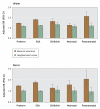Effect of neighbourhood income and maternal education on birth outcomes: a population-based study
- PMID: 16682708
- PMCID: PMC1455422
- DOI: 10.1503/cmaj.051096
Effect of neighbourhood income and maternal education on birth outcomes: a population-based study
Abstract
Background: Maternal socioeconomic status (SES) is an important determinant of inequity in maternal and fetal health. We sought to determine the extent to which associations between adverse birth outcomes and SES can be identified using individual-level measures (maternal level of education) and community-level measures (neighbourhood income).
Methods: In Quebec, the birth registration form includes a field for the mother's years of education. Using data from birth registration certificates, we identified all births from 1991 to 2000. Using maternal postal codes that can be linked to census enumeration areas, we determined neighbourhood income levels that reflect SES.
Results: Lower levels of both maternal education and neighbourhood income were associated with elevated crude risks of preterm birth, small-for-gestational-age (SGA) birth, stillbirth and neonatal and postneonatal death. The effects of maternal education were stronger than, and independent of, those of neighbourhood income. Compared with women in the highest neighbourhood income quintile, women in the lowest quintile were significantly more likely to have a preterm birth (adjusted odds ratio [OR] 1.14, 95% confidence interval [CI] 1.10-1.17), SGA birth (OR 1.18, 95% CI 1.15-1.21) or stillbirth (OR 1.30, 95% CI 1.13-1.48); compared with mothers who had completed community college or at least some university, mothers who had not completed high school were significantly more likely to have a preterm birth (adjusted OR 1.48, 95% CI 1.44-1.52), SGA birth (OR 1.86, 95% CI 1.82-1.91) or stillbirth (OR 1.54, 95% CI 1.36-1.74).
Interpretation: Individual and, to a lesser extent, neighbourhood-level SES measures are independent indicators for subpopulations at risk of adverse birth outcomes. Women with lower education levels and those living in poorer neighbourhoods are more vulnerable to adverse birth outcomes and may benefit from heightened clinical vigilance and counselling.
Figures

Comment in
-
Socioeconomic inequality in birth outcomes: what do the indicators tell us, and where do we find the data?CMAJ. 2006 May 9;174(10):1429-30. doi: 10.1503/cmaj.060349. CMAJ. 2006. PMID: 16682710 Free PMC article. No abstract available.
References
-
- Bhutta ZA, Darmstadt GL, Hasan BS, et al. Community-based interventions for improving perinatal and neonatal health outcomes in developing countries: a review of the evidence. Pediatrics 2005;115(Suppl 2):519-617. - PubMed
-
- Health Canada. A proactive approach to good health. Available: www.oag-bvg.gc.ca/domino/reports.nsf/html/0109ce.html (accessed 2006 Feb 23).
-
- Health Canada. Canadian Perinatal Health Report, 2003. Ottawa: Public Health Agency of Canada; 2003.
Publication types
MeSH terms
LinkOut - more resources
Full Text Sources
